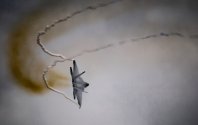You are using an out of date browser. It may not display this or other websites correctly.
You should upgrade or use an alternative browser.
You should upgrade or use an alternative browser.
J-35A fighter (PLAAF) + FC-31 thread
- Thread starter ACuriousPLAFan
- Start date
What I mean is straight forward, we all know RD-93 is well-known with its smoke. When this engine is also so smoky, it makes me think that it's something derived from RD-93.

By RD93 or derivative also?
Afaik I can't at least ID engine type based on what smoke it gives off at low RPM speeds. I'd imagine that the surrounding climate has just as much if not more effect on what the smoke looks like.
In the above pic, it's more yellowish and heavy compared to the thin darker J-35 smoke, but I don't think it's due to different engine characteristics, it's just due to lighting/local weather.
From a layman's understanding and logical inference, smoke from different engines should be indistinguishable since the cause is always the same (throttling the RPM at low speeds to conserve engine), and any modern engine allows throttling.
It's the max performance traits (shock diamonds etc.) that look different depending on thrust to weight ratio.
Take it with a grain of salt tho.
Last edited:
The F-22 stands for Fraud 22 FRAUD ALERT!View attachment 139361
By RD93 or derivative also?
Afaik I can't at least ID engine type based on what smoke it gives off at low RPM speeds. I'd imagine that the surrounding climate has just as much if not more effect on what the smoke looks like.
In the above pic, it's more yellowish and heavy compared to the thin darker J-35 smoke, but I don't think it's due to different engine characteristics, it's just due to lighting/local weather.
From a layman's understanding and logical inference, smoke from different engines should be indistinguishable since the cause is always the same (throttling the RPM at low speeds to conserve engine), and any modern engine allows throttling.
It's the max performance traits (shock diamonds etc.) that look different depending on thrust to weight ratio.
Take it with a grain of salt tho.
antiterror13
Brigadier
Very interesting to find out how much this baby J-35/A would cost per plane, how much cheaper than J-20 and how much more expensive than J-10C. Obviously would be between the two. Would it be possible after mass produced, to reach cost ~parity with J-10C ?
F-35 wing actuators look more optimized for stealth vs J-20, wont be surprised if they make it to the J20 future variants.
why would it obviously cheaper than J-20?Very interesting to find out how much this baby J-35/A would cost per plane, how much cheaper than J-20 and how much more expensive than J-10C. Obviously would be between the two. Would it be possible after mass produced, to reach cost ~parity with J-10C ?
It uses 2 engines and its electronics likely only slightly smaller than that of J-20. It's probably at 2/3 to 3/4 of the material that's used on J-20. This is not a small aircraft.
J-20 uses an engine that's fully scaled up already. It's own production is also scaled up to 100 and likely going a lot higher.
Until J-35 production scales up to at least 50 a year, I don't see why this would be cheaper than J-20.
antiterror13
Brigadier
why would it obviously cheaper than J-20?
It uses 2 engines and its electronics likely only slightly smaller than that of J-20. It's probably at 2/3 to 3/4 of the material that's used on J-20. This is not a small aircraft.
J-20 uses an engine that's fully scaled up already. It's own production is also scaled up to 100 and likely going a lot higher.
Until J-35 production scales up to at least 50 a year, I don't see why this would be cheaper than J-20.
That's what I meant (and I said it) when it is mass produced. WS-15 obviously more powerful and more expensive than WS-19, even the core technology may be similar
We don't know what the production cost of J-35 will be in a few years, but J-20 is already quite low.That's what I meant (and I said it) when it is mass produced. WS-15 obviously more powerful and more expensive than WS-19, even the core technology may be similar
When we are think about J-35 usage and deployment, I wouldn't say lower price as a main reason for PLAAF buying it. Among economics reason, you could certainly argue that a larger air force order would lower the price for naval variant. That might be a better angle to think about things.
We don't know what the production cost of J-35 will be in a few years, but J-20 is already quite low.
When we are think about J-35 usage and deployment, I wouldn't say lower price as a main reason for PLAAF buying it. Among economics reason, you could certainly argue that a larger air force order would lower the price for naval variant. That might be a better angle to think about things.
And IMO it has a clear industrial political aspect: CAC alone cannot produce all fighters for the PL and having as well as retaining a second team capable to develop and produce fighters is keeping technological and industrial sources.







